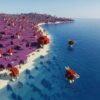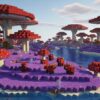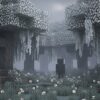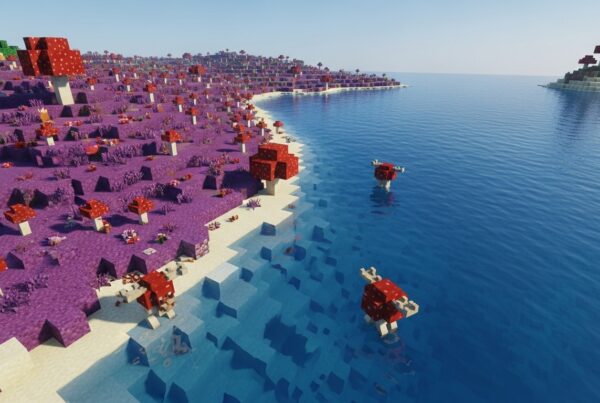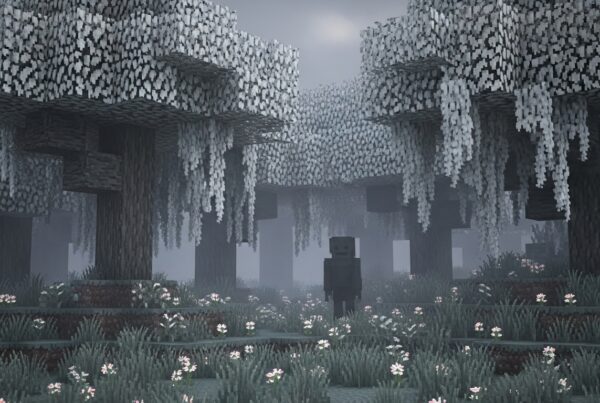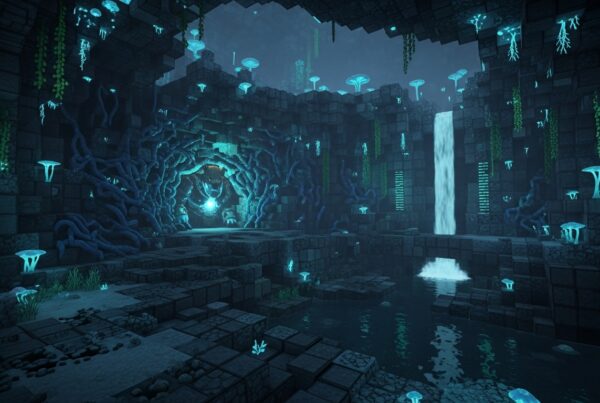The Mushroom Fields biome is one of the rarest and most fascinating regions in Minecraft. Defined by its purple-gray mycelium terrain, towering mushrooms, and friendly Mooshrooms, this biome offers complete safety from hostile mobs and a valuable set of unique resources. This in-depth guide covers everything—from features and benefits to exploration strategies, building tips, and recommended seeds.
What Is the Mushroom Fields Biome?
Biome Characteristics
Mushroom Fields (sometimes called Mushroom Islands) are extremely rare Overworld biomes. They appear as isolated landmasses, generally surrounded by oceans, and have the following characteristics:
- Surface covered entirely in mycelium, which replaces grass and dirt.
- Naturally generated giant red and brown mushrooms.
- Presence of the exclusive mob: the Mooshroom.
- No hostile mobs spawn on the surface or underground under normal conditions.
- The Mushroom Field Shore variant exists around edges where the island meets ocean.
Climate & Temperature
This biome has a neutral climate and extremely stable weather conditions:
- No rain occurs in Mushroom Fields (on the surface).
- No snow falls—regardless of light level or altitude.
- The biome’s temperature is moderate, meaning no precipitation changes or temperature-driven biome effects.
Unique Features of the Mushroom Fields Biome
Mycelium
Mycelium is a block unique to this biome and has several helpful properties:
- It spreads similarly to grass, but only onto adjacent dirt blocks and requires light level 9 or greater to spread.
- Mushrooms (red or brown) can grow on mycelium in any light level, making it ideal for underground mushroom farms.
- You can harvest mycelium with a Silk Touch tool and bring it to other biomes to create mycelium-based farms or decorative terrain.
- Mycelium prevents hostile mobs from spawning on it (on the surface) because the biome’s spawn rules forbid them.
Tip: If you’re terraforming the biome or building large mushroom farms, consider creating a ring of dirt or barrier blocks to prevent unwanted mycelium spread.
Giant Mushrooms
Giant mushrooms occur naturally in Mushroom Fields, adding distinctive visual flair and farming opportunities.
- There are two types: Giant Red Mushrooms and Giant Brown Mushrooms.
- Players can grow them themselves by placing a regular mushroom on a suitable block (mycelium, podzol, dirt or coarse dirt) and applying bone meal, provided there is enough vertical space.
- Red mushroom growth typically requires ~7 blocks of vertical clearance.
- Brown mushroom growth typically requires ~13 blocks.
- These large mushrooms provide large volumes of mushroom blocks for decoration or building projects.
Mooshrooms
Mooshrooms are exclusive to the Mushroom Fields biome and offer many benefits.
Types & Behavior:
- Red Mooshrooms are the default form in Mushroom Fields.
- Brown Mooshrooms can be obtained when a red Mooshroom is struck by lightning (or via a Trident with Channeling during a thunderstorm in Java).
- Mooshrooms can be milked like cows, and when fed a flower, they produce suspicious stew with random potion effects.
Benefits:
- Provide an unlimited renewable food source—you can shear them to get mushrooms or milk them for stew.
- Suspicious stew from Mooshrooms offers a wide variety of effects (such as Night Vision, Saturation, Fire Resistance, etc.).
- Perfect for bases due to their safety (no hostile mobs around) and utility.
No Hostile Mob Spawns
One of the major draws of the Mushroom Fields biome is the lack of surface hostile mobs.
- Zombies, skeletons, creepers, spiders, and endermen do not spawn on the mycelium surface.
- Even large caves beneath the island tend to be mob-free on the surface level, making them ideal for secure mining or redstone builds.
- This creates a safe environment for both novice players and large scale builds.
Mushroom Field Shore
The Mushroom Field Shore is a smaller biome variation found around the edges of Mushroom Field islands where land meets ocean. It features:
- Mycelium ground that slopes into the water.
- Similar spawn rules (no hostile mobs) in the immediate region.
- Often shorter giant mushrooms and a thinner landmass.
Blocks, Items, and Resources Found Here
| Resource | Description | Use Cases |
|---|---|---|
| Mycelium | Biome’s ground block | Mushroom farming, aesthetic builds |
| Red & Brown Mushrooms | Found naturally and via giant mushrooms | Brewing, mushroom stew, crafting |
| Mushroom Blocks | Harvested from giant mushrooms | Decorative building blocks |
| Mooshrooms | The only natural mob in the biome | Food, suspicious stew, breeding |
| Small Mushrooms | Spawn freely on mycelium | Farming, renewable resources |
How to Find a Mushroom Fields Biome
Natural Generation
Mushroom Fields generate more often in certain ocean biomes:
- They commonly generate in warm or lukewarm oceans, sometimes deep ocean biomes.
- They are rare and often far from spawn — you may need to travel hundreds or thousands of blocks to locate one.
Best Exploration Methods
To locate a Mushroom Fields island effectively, try the following strategies:
- Travel by boat across warm or lukewarm ocean biomes — these islands often appear as isolated land masses.
- Use an Elytra and fireworks for fast aerial scanning of large ocean areas.
- Use mapping or coordinate-tracker tools (in-game maps, third-party web tools like Chunkbase) to mark large ocean zones and find suitable islands.
- When you find a candidate island of mycelium terrain, verify by looking for giant mushrooms and Mooshrooms.
Using Commands and Seed Tools
For players seeking a more direct approach:
- Use the /locate biome mushroom_fields command in Java Edition to jump directly to the nearest Mushroom Fields biome.
- Use third-party seed explorer tools (e.g., Chunkbase) to preview world seeds and identify Mushroom Fields from spawn.
How to Build and Survive in Mushroom Fields
Best Uses for the Biome
Because of the unique spawn rules and resources, Mushroom Fields serve very well for:
- Safe base building: Without hostile mobs, you can build large bases without worrying about defending them at night.
- Automatic farms and redstone builds: No surprise spawn waves make this biome ideal for reliable redstone contraptions.
- Animal breeding hubs: Mooshrooms give you food and materials; bring other animals in for variety.
- Mega mushroom farms: Leverage the mycelium surface to grow massive quantities of mushrooms quickly.
- Unique aesthetic builds: The mycelium and giant mushrooms give a whimsical, other-worldly look suitable for themed builds (fairy-tale, alien, mystical, etc.).
Challenges of Living Here
While the biome is very advantageous, some potential drawbacks to plan for:
- Lack of trees: No natural tree generation occurs here. You’ll need to bring saplings or logs from other biomes to establish wood supply.
- Limited passive mob variety: Only Mooshrooms spawn naturally. To bring in other animals (cows, sheep, chickens, pigs), you must transport them or breed them artificially.
- Sparse vegetation: Grass, flowers, and typical farmland environments aren’t common here. For aesthetics or additional farming, you’ll need to import or create them.
Pro Tip: Bring saplings, seeds, and build a small tree farm on arrival. Also bring a few other passive mobs to diversify your resource base.
Exploration Tips
Here are practical tips to make your journey smoother and more productive:
- Bring plenty of wood and saplings because trees don’t grow naturally on the island.
- Use mycelium for mushroom farming — plant small mushrooms on the mycelium, then sunlight or light levels don’t matter.
- If you want grass for aesthetic or layout reasons, cover mycelium with dirt and plant grass or trees, then isolate it so mycelium doesn’t overtake the area.
- Explore underground caves beneath the island: They tend to be safer than typical Overworld caves because surface mob spawning is suppressed above them.
- Use the environment: Many Mushroom Fields islands are near ocean structures like shipwrecks, ocean ruins, or even ocean monuments — use these to gather loot and resources early.
Recommended Seeds
Here are verified seeds for both Java and Bedrock editions that are known to feature Mushroom Fields islands fairly close to spawn. Always check version compatibility (ideally 1.20+ or 1.21+) for best results.
Java Edition Seeds
| Seed Value | Description |
|---|---|
| 1501813564714336673 | “Three Connected Mushroom Islands” – multiple Mushroom Fields connected by narrow strips. Pro Game Guides |
| -8936702305531883130 | “Massive Mushroom Island” – large island ~500 blocks from spawn. Pro Game Guides |
| -1075708716890725434 | “Warm Mushroom Cove” – two Mushroom Islands in coral-reef and warm ocean environment. Pro Game Guides |
Bedrock Edition Seeds
| Seed Value | Description |
|---|---|
| 3903589 | Verified seed for Bedrock 1.21.0 where you spawn near a Mushroom Island. DigMinecraft |
| 16634556 | Reddit-shared seed for 1.21 (Java & Bedrock) with large Mushroom Island. Reddit |
Note: Even if a seed is listed as valid for a specific version (e.g., 1.20 or 1.21), terrain generation mechanics may differ slightly between Java and Bedrock, so the layout and structures might vary. Always check before playing a long term survival world.
Frequently Asked Questions (FAQ)
Do hostile mobs ever spawn here?
No. Under standard Overworld spawn conditions, hostile mobs do not spawn on the surface of the Mushroom Fields biome. Even the caves beneath tend to be safe due to spawn-rule quirks.
Can mycelium be taken or spread elsewhere?
Yes. You can collect mycelium using a Silk Touch tool, then place it somewhere else. Mycelium will spread to adjacent dirt blocks under light level 9+. To prevent unwanted spread, isolate non-mycelium blocks with barrier blocks.
How do I get Brown Mooshrooms?
Simply strike a Red Mooshroom with lightning during a thunderstorm, or use a Trident with Channeling in Java Edition. The Red turns into a Brown Mooshroom.
Can villagers live in Mushroom Fields?
Yes. Villagers and village mechanics work normally here. Since no zombies spawn on the surface, villagers are exceptionally safe from raids and zombie infections, making this biome an excellent village location.
Brief History & Update Notes
- In earlier versions (pre-1.8), Mushroom Islands were more common. Their rarity has increased with updated terrain generation.
- The mechanics for Mooshrooms changed in 1.14 with the addition of suspicious stew.
- Mycelium and mushroom farming mechanics have been refined in later updates, including spread and growth thresholds.
- Certain terrain features differ between Java Edition and Bedrock Edition even when the same seed is used, so always test if you switch platforms.
Conclusion
The Mushroom Fields biome is one of the safest, most unique, and resource-rich biomes in Minecraft. With its no-hostile-mob surface, abundant mycelium, giant mushrooms, and Mooshrooms, it provides unmatched opportunities for safe base building and creative exploration. Whether you’re building a mega mushroom farm, a themed aesthetic base, or simply looking for a peaceful survival start, this biome delivers. Use the recommended seeds, bring your starter supplies, and dive in—you’ve found one of Minecraft’s rarities worth exploring.

